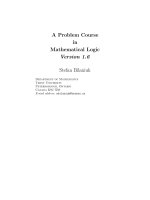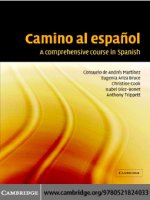A Short Course in Predicate Logic
Bạn đang xem bản rút gọn của tài liệu. Xem và tải ngay bản đầy đủ của tài liệu tại đây (10.01 MB, 180 trang )
AShortCourseinPredicateLogic
JeffParis
Downloadfreebooksat
Jef Paris
A Short Course in Predicate Logic
2
Download free eBooks at bookboon.com
A Short Course in Predicate Logic
1st edition
© 2015 Jef Paris & bookboon.com
ISBN 978-87-403-0795-5
Download free eBooks at bookboon.com
Contents
A Short Course in Predicate Logic
Contents
Introduction
6
Motivation
7
Formal Languages, Formulae and Sentences
11
Truth
18
Logical Consequence
25
he Prenex Normal Form heorem
35
Formal Proofs
44
he Completeness and Compactness heorems
50
Adding Constants and Functions
69
www.sylvania.com
We do not reinvent
the wheel we reinvent
light.
Fascinating lighting offers an ininite spectrum of
possibilities: Innovative technologies and new
markets provide both opportunities and challenges.
An environment in which your expertise is in high
demand. Enjoy the supportive working atmosphere
within our global group and beneit from international
career paths. Implement sustainable ideas in close
cooperation with other specialists and contribute to
inluencing our future. Come and join us in reinventing
light every day.
Light is OSRAM
4
Download free eBooks at bookboon.com
Click on the ad to read more
A Short Course in Predicate Logic
Contents
Herbrand’s heorem
89
Equality
95
Exercises
115
Solutions to the Exercises
130
Appendix
176
Endnotes
178
360°
thinking
.
Discover the truth at www.deloitte.ca/careers
5
Download free eBooks at bookboon.com
© Deloitte & Touche LLP and affiliated entities.
Click on the ad to read more
A Short Course in Predicate Logic
Introduction
Introduction
In our everyday lives we oten employ arguments to draw conclusions. In turn we expect others to follow
our line of reasoning and thence agree with our conclusions. his is especially true in mathematics
where we call such arguments ‘proofs’ But why are these arguments or proofs so convincing, why should
we agree with their conclusions? What is it that makes them ‘valid’? In this course we will attempt to
formalize what we mean by these notions within a context/language which is adequate to express almost
everything we do in mathematics, and much of everyday communication as well.
he presentation given here derives from a lecture course given in the School of Mathematics at
Manchester University between 2010 and 2013. Previous to that courses covering similar topics had
run for many years with ever diminishing student numbers, the students seemingly inding the notation
bewildering and the level of rigor and nit picking detail excessive. As a result they oten gave up before
the point of realizing how easy, self-evident and downright interesting the subject really is. he primary
aim of this current version then was to adopt an approach which avoided as far as possible those initial
barriers, and which reached some of the ‘good stuf ’ before any risk of disheartenment setting in.
hat is not to say that the approach given here lacks rigor or is at some points ‘not quite right’. Far from
it. But we will on occasions implicitly accept as obvious or self-evident facts which, looking back later,
you might question. If so then that is the time to check for yourself that what has been taken for granted
in the text is indeed perfectly correct.
In terms of the choice of material in the course the intention is that it will provide a irm grounding in
Predicate Logic such as is necessary for further ields in Mathematical Logic, for example Proof heory,
Model heory, Set heory, as well as Philosophical Logic and the diverse applications in Computer
Science. In addition, with its presentation of the Completeness heorem, it aims to provide a broad picture
and understanding of relationship between proof and truth and the nature of mathematics in general.
hese notes can be studied at two levels, in UK terms Bachelors and Masters. he more demanding
material and exercises, primarily aimed at the Master level is marked with an asterisk, *. Unmarked
material is intended for both levels and is self contained, requiring nothing from the upper level.
6
Download free eBooks at bookboon.com
A Short Course in Predicate Logic
Motivation
Motivation
Consider the following examples of ‘reasoning’:
1(a)
10 is a number which is the sum of 4 squares
∴ There is a number which is the sum of 4 squares
2(a)
Every student at this University pays fees
Monica is a student at this University
∴ Monica pays fees
In each case the conclusion seems to ‘follow’ from the assumptions/premises. But in what sense? What
do we mean by ‘follows’? Since such arguments are common in our everyday lives, especially when as
mathematicians we produce proofs of theorems, it would seem worthwhile to understand and answer
this question, and that’s what logic is all about, it’s the study of ‘valid reasoning or argument’.
In both the above examples the reasoning seems to be ‘valid’ (which right now just equates with ‘OK’),
but what does this mean? A irst guess here is that it means: he conclusion is true given that the premises
are true. his is close, but we have to be careful here. Consider for example the argument:
3(a)
There is a number which is the sum of 4 squares
∴ Every number is the sum of 4 squares
his does not seem to be ‘valid’ in the sense of the irst two examples, despite the fact that the assumption
and conclusion are actually true.
he reason the irst two arguments are valid and the last is not is that they do not actually depend on
the meaning of ‘sum of 4 squares’, ‘Monica’, ‘10’, ‘student at this university’, ‘pays fees’ nor what universe
of objects (natural numbers in the irst and last, people, say, in the second) we are referring to, whereas
in the last the meaning of ‘is the sum of 4 squares’ does matter. For example if we change ‘sum of 4
squares’ to ‘sum of 3 squares’ then the premiss is true but the conclusion false.
To see this let’s write
∀ for ‘for all’
∃ for ‘there exists’
c for 10
P (x) for ‘x is the sum of 4 squares’
7
Download free eBooks at bookboon.com
A Short Course in Predicate Logic
Motivation
hen our irst and last examples become:
1(b)
P (c)
∴ ∃x P (x)
3(b)
∃x P (x)
∴ ∀x P (x)
Clearly the conclusion in the irst of these ‘follows’ no matter what universe the x ranges over, no matter
what element of that universe c stands for and no matter what property of x P (x) stands for. In other
words no matter what they stand for if the premises are true then so is the conclusion. For example if
we take this universe to be the set of all buses along Oxford Road, c to stand for the number 43 bus and
P (x) to mean that bus x goes to the airport then the irst argument would become
1(c)
The 43 bus goes to the airport
∴ There is a bus on Oxford Road which goes to the airport
which we would surely accept as ‘OK’.
However in the second case we obtain
3 (c)
There is a bus on Oxford Road which goes to the airport
∴ All buses along Oxford Road go to the airport
and now the conclusion is false, whilst the premiss is true, so this is clearly not an OK argument.
Similarly in the Monica example if we let
m stand for Monica
S(x) stand for ‘x is a student at this university’
F (x) stand for ‘x pays fees’
! stand for ‘if … then’, equivalently ‘implies’,
then the example becomes
2 (b)
8x (S(x) ! F (x))
S(m)
∴ F (m)
and again this looks an OK argument no matter what universe of objects the variable x ranges over,
no matter what element of this universe m stands for and no matter what properties of such x, S(x)
and F (x) stand for.
8
Download free eBooks at bookboon.com
A Short Course in Predicate Logic
Motivation
In other words, no matter what meaning (or interpretation) we give to this universe, m and S(x), F (x), if the
premises are true then so is the conclusion. he validity of the Monica example 2 derives from this fact.
he non-validity of our ‘all numbers are the sum of 4 squares’ example 3 is a consequence of this failing
in this case, despite the fact that in this interpretation the conclusion of 3(a) is true.
What we have learnt here is that to understand and investigate ‘valid’ arguments we need to study formal
examples like the one above where all meaning has been stripped away, where we have been let with
just the essential bare bones.
Before doing that however it will be useful to give two more examples which introduce another (small)
point. Consider the following, where ‘number’ means ‘natural number’:
4 (a)
There is a number which is less or equal any number
∴ For every number there is a number which is less or equal to it
5 (a)
For every number there is a number which is less or equal to it
∴ There is a number which is less or equal any number
In these cases both the premiss and conclusion are true. However it is only in the irst that the conclusion
seems to be valid, in other words to ‘follow’ from the premise. Again if we let x, y range over natural
numbers and let Q(x, y ) stand for x is less or equal y then they become respectively:
4 (b)
∃x ∀y Q(x, y )
∴∀y ∃x Q(x, y )
5 (b)
∀y ∃x Q(x, y )
∴∃x ∀y Q(x, y )
he validity of the former is (quite) easy to see. For clearly no matter what universe the x, y range over
and no matter what binary (or 2-ary) relation on the universe Q stands for, if the premise is true then
so is the conclusion. his holds simply because of the forms of the premise and conclusion, not because
of how we interpreted them here.
On the other hand this ‘logical’ connection between the premise and the conclusion does not hold in
the second case. If we interpret the variables x, y as ranging over the universe of natural numbers1
but interpret Q as the ‘greater or equal than’ relation then the argument interprets as:
5 (c)
For every number there is a number which is greater or equal to it.
∴There is a number which is greater or equal any other number
so the premise is true whilst the so-called conclusion is false.
9
Download free eBooks at bookboon.com
A Short Course in Predicate Logic
Motivation
As our inal example consider:
6 (a)
x5 = 2x − 1
∴ ∃w w5 = 2w − 1
One’s irst thought maybe is that the variable x here is supposed to be a real number, and that the
conclusion follows (trivially even) from the premiss. However the conclusion obviously follows whether
we’re thinking here of x being a real, or a complex number, or a 4 × 4 matrix or indeed an element of
any algebraic structure in which the functions x x5 and x 2x − 1 have some meaning.
To sum up then we could say that in examples 1, 2, 4, 6 the conclusion follows logically from the premise(s)
whereas in examples 3, 5, it does not. It is this notion of ‘logical consequence’ that this course, and Logic
in general, is interested in.Our above considerations lead us to propose a rough deinition of an assertion
φ being a logical consequence of assumptions/premises θ1 , θ2 , ,θ n . Namely this holds if no matter
how we interpret the range of the variables, the relations, the constants etc. if θ1 , θ2 , ,θ n are all true
then φ will be true. To make this a precise deinition we need to say what θ1 , ,θ n , φ can be, what
we mean by an ‘interpretation’ and even what we mean by ‘true’. We start with the former.
10
Download free eBooks at bookboon.com
A Short Course in Predicate Logic
Formal Languages, Formulae and Sentences
Formal Languages, Formulae
and Sentences
We have seen in the last section that to study valid reasoning we are led to consider formalized, abstract,
assertions such as P (c), ∃x P (x) , ∀x (S(x) → F (x)) , ∃x ∀y Q(x, y ) , ∀y ∃x Q(x, y ) , x5 = 2x + 1
appearing in 1(b), 2(b) and 5(b). Expressions which can arise in this way will be called formulae of a
language. Formally they are simply words built up from the symbols2 listed below in speciied, ‘wellformed’, ways (so as to make sense):
Symbol
Standing for
Relation symbols e.g. P , S , Q etc
unary, binary, etc. relations
Constant symbols, e.g. c, m etc.
constants
Function symbols, e.g. + etc.
unary, binary, etc. functions
Equality symbol, =
the binary relation of equality
Variables, x, w etc.
variable elements of the universe on which the quantiiers, relations,
functions operate
Connectives: !
implication, ‘implies’ or ‘if then’
^
_
:
Quantiiers: 8w
9w
Parenthesis (, )
conjunction, ‘and’
disjunction, ‘or’
negation, ‘not’
for all w (Universal quantiication)
there exists w (Existential quantiication)
punctuation
he available relation, function, constant, and if present equality symbols3, are said4 to comprise the
language of which such expressions are formulae. he language we are working in will vary whilst the
remaining symbols are the same in all cases.
Deinition A language L is a set consisting of some relation symbols (possibly including = ) and
possibly some constant, function symbols. Each relation and function symbol in L has an arity (e.g.
unary, binary, ternary, etc.).5
For example we could have L = {P , Q, c, f } where P is a 1-ary or unary relation symbol, Q is a
2-ary or binary relation symbol, f is a unary function symbol and c is a constant symbol.
We use L, L¢, L1 , L2 , etc. to denote languages.
11
Download free eBooks at bookboon.com
A Short Course in Predicate Logic
Formal Languages, Formulae and Sentences
To make things ultimately simpler (though it might not seem like that at irst) we will use x1 , x2 , x3 ,
for free variables, that is variables which are not linked to a quantiier, and w1 , w2 , w3 , for bound
variables, that is variables which are linked with a quantiier.
In order to avoid a lood of notation too early on we shall start by limiting ourselves to relational languages,
that is languages which have no function, constant symbols, nor equality.
Deinition For L a (relational) language the formulae of L are deined as follows:
Ll If R is an n -ary relation symbol of L and xi , xi , , xi (not necessarily distinct) come from
1
2
n
the set of free variables {x1 , x2 , x3 , } then R(xi , xi , , xi ) is a formula of L .
1
2
n
L2 If µ, Á are formulae of L then so are (µ ! Á) , (µ ^ Á) , (µ _ Á) ,
:µ .
L3 If φ is a formula of L which does not mention wj and Á(wj / xi ) is the result of replacing
the free variable xi everywhere in φ by the bound variable wj then ∃wj Á(wj / xi ) ,
8wj Á(wj / xi ) are formulae of L .
L4 φ is a formulae of L just if this follows in a inite number of steps from Ll-3.
We denote the set of all formulae of L by FL . We use µ, Á, Ã, Â etc. to denote formulae and ¡; ¢;
etc. to denote sets of formulae, possibly empty. Notice that in L3 since we have ininitely many bound
variables available and any one formula only mentions initely many bound (or free) variables we can
always pick one which doesn’t appear already.
Example
In this example let the language L = {P , R} where P is a unary relation symbol and R a ternary
relation symbol hen.
1. R(x3 , x3 , x1 ) is a formula of L , equivalently R(x3 , x3 , x1 ) ∈ FL , by Ll with
i1 = i2 = 3, i3 = 1. Similarly P (x1 ) ∈ FL.
2. From 1 and L3, ∃w1 R(w1 , w1 , x1 ) ∈ FL .
3. From 1, 2 and L2 (∃w1 R(w1 , w1 , x1 ) ! P (x1 )) ∈ FL .
4. From 3 and L3, ∀w2 (∃w1 R(w1 , w1 , w2 ) ! P (w2 )) ∈ FL .
12
Download free eBooks at bookboon.com









